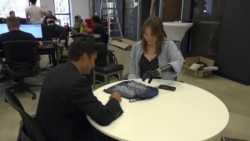((PKG)) BIONIC HAND
((TRT: 04:21))
((Topic Banner: Bionic Hand))
((Reporter/Camera/Editor/Producer: Genia Dulot))
((Map: San Diego, California))
((Main characters: 0 female; 1 male))
((Sub characters: 2 female; 0 male))
((NATS))
((Kate Ketelhohn
Disabled Cosplayer))
There is many heroes out there that do you have bionic limbs or disabilities. Typically, they are villains because of the stereotype of disabled character being villains, or there are high-tech characters like Nebula who I’m cosplaying right now that have high-tech limbs or are cyborgs.
((Kate Ketelhohn
Disabled Cosplayer))
I lost my hand to sepsis when I was an infant. Growing up, I never really saw characters like me. I really like taking parts of what makes me me, and adding it to the characters I love. It makes me feel very strong and I feel like it’s always a statement piece.
((NATS))
((Aadeel Akhtar
CEO and Founder of PSYONIC))
I’ve wanted to do this my entire life, ever since I was seven years old, to build bionic limbs. My parents are from Pakistan and I was visiting when I was seven. And that’s the first time I met someone missing a limb. And she was my age, missing her light leg, and using a tree branch as a crutch, living in the streets. That’s what inspired me to go into this field.
((Aadeel Akhtar
CEO and Founder of PSYONIC))
It works off of the muscles that are still left in your arm, right?. So, if you’re missing your arm over here, you still have muscles in your forearm that control a hand. We can tap into those muscles and then use those to actually control the different movements on the hand itself.
((NATS))
((Annika Berlin
Bionic Hand User))
The electrodes, which looks something like this, are what is pressed up against my skin, embedded in a socket on each side, and those are what reads muscle contractions.
I’m contracting like the end of my muscle, the end of my arm on this side of my arm to close it, and then I’m contracting the muscle out here to open the hand.
((Aadeel Akhtar
CEO and Founder of PSYONIC))
The muscle sensing technology had been around for a while, but it wasn’t just very accessible, and it hadn’t been applied to 3-D printed prosthetics before. We were combining all those technologies together and building our own devices that can use those technologies.
((NATS))
((Aadeel Akhtar
CEO and Founder of PSYONIC))
Mark 4 is also the first one that we were incorporating touch feedback. So we put pressure sensors into the finger. This allows our users to actually feel what they’re manipulating, what they’re grabbing.
((Annika Berlin
Bionic Hand User))
Now saying that I have feeling again would be misleading, it’s not like that at all. If anything, I like to describe it like it’s added reassurance. Grabbing my coffee in the morning, heavy glass of coffee, you know. It’s hot whatever…I get that feedback that I am holding it. And I’ve noticed that I’ve stopped like staring at my hand when I’m going to pick up a cup of coffee. I get that little vibration that I’m holding it, and I’m not staring at my hand to make sure, which is something that I’ve always used to do.
((Aadeel Akhtar
CEO and Founder of PSYONIC))
We’re working on integrating this hand directly to your bones and your nerves. So with the nerve implant technology, this is what you’d be able to do, right? So I can control each hand independently and very fluidly, right? So, the idea here is that instead of using the camera, you’d use nerve implants. And with that we’re hoping that within a couple of years, we might get our first patients to play piano or type on the keyboard again.
((NATS))
((Annika Berlin
Bionic Hand User))
Individual finger control would be awesome, and that soon we’ll know if somebody like me, somebody who is congenital, if it would be useful for me, if it would be possible.
((NATS))
((Aadeel Akhtar
CEO and Founder of PSYONIC))
So, in addition to humans using our hand, so if you’re building a robot to do the same thing that humans are, then you can use our hand for robots as well. And so, NASA is building a humanoid astronaut that they eventually want to send into space, and they were looking for a hand that they could use. So they contacted us, and to see if we can actually fit our hand on their robot.
And in this picture, you can actually see their humanoid astronaut robot, Valkyrie, using our hand. And Annie is actually fist-bumping using the exactly same hand the robot is using.
((NATS))













